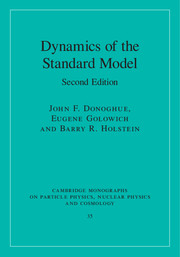Book contents
- Frontmatter
- Dedication
- Contents
- Preface to the second edition
- I Inputs to the Standard Model
- II Interactions of the Standard Model
- III Symmetries and anomalies
- IV Introduction to effective field theory
- V Charged leptons
- VI Neutrinos
- VII Effective field theory for low-energy QCD
- VIII Weak interactions of kaons
- IX Mass mixing and CP violation
- X The N−1c expansion
- XI Phenomenological models
- XII Baryon properties
- XIII Hadron spectroscopy
- XIV Weak interactions of heavy quarks
- XV The Higgs boson
- XVI The electroweak sector
- Appendix A Functional integration
- Appendix B Advanced field-theoretic methods
- Appendix C Useful formulae
- References
- Index
III - Symmetries and anomalies
- Frontmatter
- Dedication
- Contents
- Preface to the second edition
- I Inputs to the Standard Model
- II Interactions of the Standard Model
- III Symmetries and anomalies
- IV Introduction to effective field theory
- V Charged leptons
- VI Neutrinos
- VII Effective field theory for low-energy QCD
- VIII Weak interactions of kaons
- IX Mass mixing and CP violation
- X The N−1c expansion
- XI Phenomenological models
- XII Baryon properties
- XIII Hadron spectroscopy
- XIV Weak interactions of heavy quarks
- XV The Higgs boson
- XVI The electroweak sector
- Appendix A Functional integration
- Appendix B Advanced field-theoretic methods
- Appendix C Useful formulae
- References
- Index
Summary
Application of the concept of symmetry leads to some of the most powerful techniques in particle physics. The most familiar example is the use of gauge symmetry to generate the lagrangian of the Standard Model. Symmetry methods are also valuable in extracting and organizing the physical predictions of the Standard Model. Very often when dealing with hadronic physics, perturbation theory is not applicable to the calculation of quantities of physical interest. One turns in these cases to symmetries and approximate symmetries. It is impressive how successful these methods have been. Moreover, even if one could solve the theory exactly, symmetry considerations would still be needed to organize the results and to make them comprehensible. The identification of symmetries and near symmetries has been considered in Chap. I. This chapter is devoted to their further study, both in general and as applied to the Standard Model, with the intent of providing the foundation for later applications.
Symmetries of the Standard Model
The treatment of symmetry in Sects. I–4, I–6 was carried out primarily in a general context. In practice, however, we are most interested in the symmetries relevant to the Standard Model. Let us briefly list these, reserving for some a much more detailed study in later sections.
- Type
- Chapter
- Information
- Dynamics of the Standard Model , pp. 76 - 105Publisher: Cambridge University PressPrint publication year: 2014

